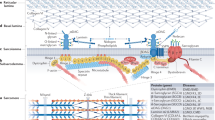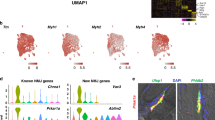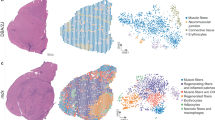Abstract
THE pathological changes in the muscle in human muscular dystrophy have been well characterized. They consist of great diversity of muscle fibre size, increase in number of sarcolemmal nuclei (which may take the form of chains situated centrally in the fibre), and atrophy of the fibres. Although it has been said1 that phagocytosis of degenerating fibres is rare, we have found evidence in a number of cases of what appears to be invasion and destruction of muscle fibres by elements of connective tissue.
This is a preview of subscription content, access via your institution
Access options
Subscribe to this journal
Receive 51 print issues and online access
$199.00 per year
only $3.90 per issue
Buy this article
- Purchase on SpringerLink
- Instant access to full article PDF
Prices may be subject to local taxes which are calculated during checkout
Similar content being viewed by others
References
Adams, R. D., Denny-Brown, D., and Pearson, C. M., “Diseases of Muscle”, 259 (Paul B. Hoeber, 1954).
Beckett, E. B., and Bourne, G. H., J. Neuropath. Exp. Neurol., 17, 2, 199 (1958).
Author information
Authors and Affiliations
Rights and permissions
About this article
Cite this article
BOURNE, G., GOLARZ, M. Human Muscular Dystrophy as an Aberration of the Connective Tissue. Nature 183, 1741–1743 (1959). https://doi.org/10.1038/1831741a0
Issue date:
DOI: https://doi.org/10.1038/1831741a0
This article is cited by
-
A role for collagen in the pathogenesis of muscular dystrophy?
Nature (1980)
-
�ber den histochemischen Leucin-Aminopeptidase-Nachweis in der menschlichen Skeletmuskulatur bei verschiedenen Myopathien
Virchows Archiv Abteilung A Pathologische Anatomie (1969)
-
Leucine aminopeptidase activity in muscles of dystrophic mice
Experientia (1964)
-
Biochemie der progressiven Muskeldystrophie
Klinische Wochenschrift (1962)
-
Effects of denervation and treatment with nucleotides on phosphatase reactions in muscles of rats
Acta Neuropathologica (1962)



